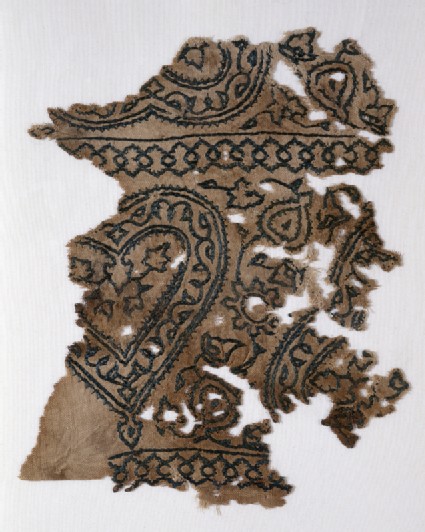Embroideries and Samplers from Islamic Egypt
A selection of 10th to 16th century embroideries from the Newberry collection at the Ashmolean by Marianne Ellis (published Oxford, 2001).

Publications online: 66 objects
- Reference URL
Actions
Textile fragment with hearts
-
Literature notes
There are a number of embroideries in the collection with linear designs of buds and leaves on scrolling stems, palmettes, lobed rosettes and heart motifs. Almost all are worked in blue silk thread. Enough of this one has survived for us to see that originally the heart shapes were arranged alternately in upright and reversed positions. Radiocarbon dating has provided an age range starting before the Mamluk period. Looking at the whole category, however, this early date is unlikely, particularly as some are also embroidered with Mamluk heraldic blazons. One in the Röhss Museum of Applied Art and Design, Gothenburg (Sweden) has the emblem of a royal cup-bearer embroidered on a corner. All examples are worked in split or stem stitches; sometimes both stitches occur on the same piece since the only difference is whether the needle is brought up through or at one side of the previous stitch. In the case of this example, instead of working all the split stitches in the usual straight lines, the embroiderer has formed little points by changing the direction of the needle. Generally speaking, there are not a great many different stitches but there are quite a few variations of the basic ones. Here the contrast between smooth and jagged stitched outlines adds considerably to the decorative effect. Some of the motifs on Mamluk silk woven fabrics have scalloped or stepped outlines which might possibly have influenced the design of this embroidery. -
Details
- Associated place
-
Near East (place of creation)
- Material and technique
- linen, embroidered with blue silk
- Dimensions
-
21.5 x 17.5 cm max. (length x width)
along length/width 21 / 19 threads/cm (thread count)
ground fabric 0.05 cm (thread diameter)
additional fibre, embroidery 0.1 cm (thread diameter)
- Material index
-
organic › animal › animal product › silk
- Technique index
-
woven › plain woven,assembled › woven › plain woven,
- Object type index
- No. of items
- 1
- Credit line
- Presented by Professor Percy Newberry, 1941.
- Accession no.
- EA1993.230
-
Further reading
Ellis, Marianne, Embroideries and Samplers from Islamic Egypt (Oxford: Ashmolean Museum, in association with Greenville: Curious Works Press, 2001), no. 43 on p. 64, pp. 10 & 65, illus. p. 64
Barnes, Ruth and Marianne Ellis, ‘The Newberry Collection of Islamic Embroideries’, 4 vols, 2001, Oxford, Ashmolean Museum, cat. p. 191 (vol. iv), illus. vol. iv p. 191
Location
-
- currently in research collection
Objects are sometimes moved to a different location. Our object location data is usually updated on a monthly basis. Contact the Jameel Study Centre if you are planning to visit the museum to see a particular object on display, or would like to arrange an appointment to see an object in our reserve collections.
Publications online
-

Embroideries and Samplers from Islamic Egypt
There are a number of embroideries in the collection with linear designs of buds and leaves on scrolling stems, palmettes, lobed rosettes and heart motifs. Almost all are worked in blue silk thread. Enough of this one has survived for us to see that originally the heart shapes were arranged alternately in upright and reversed positions. Radiocarbon dating has provided an age range starting before the Mamluk period. Looking at the whole category, however, this early date is unlikely, particularly as some are also embroidered with Mamluk heraldic blazons. One in the Röhss Museum of Applied Art and Design, Gothenburg (Sweden) has the emblem of a royal cup-bearer embroidered on a corner. All examples are worked in split or stem stitches; sometimes both stitches occur on the same piece since the only difference is whether the needle is brought up through or at one side of the previous stitch. In the case of this example, instead of working all the split stitches in the usual straight lines, the embroiderer has formed little points by changing the direction of the needle. Generally speaking, there are not a great many different stitches but there are quite a few variations of the basic ones. Here the contrast between smooth and jagged stitched outlines adds considerably to the decorative effect. Some of the motifs on Mamluk silk woven fabrics have scalloped or stepped outlines which might possibly have influenced the design of this embroidery. -

The Newberry Collection of Islamic Embroideries
A scrolling stem with hearts and an eight-lobed rosette is set between the remains of heart-shapes filled with scrolling tendrils and leaves; on two sides there are narrow borders of intersecting diamonds.
The C-14 result dates the fragment 1280 +/- 50.
Notice
Object information may not accurately reflect the actual contents of the original publication, since our online objects contain current information held in our collections database. Click on 'buy this publication' to purchase printed versions of our online publications, where available, or contact the Jameel Study Centre to arrange access to books on our collections that are now out of print.
© 2013 University of Oxford - Ashmolean Museum

